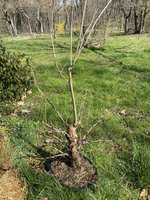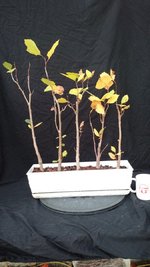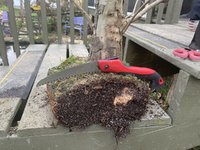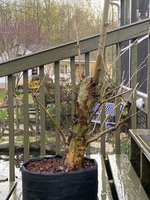You are using an out of date browser. It may not display this or other websites correctly.
You should upgrade or use an alternative browser.
You should upgrade or use an alternative browser.
Five Year Native Tree Challenge: Gabler's American Sycamore
- Thread starter Gabler
- Start date
Cmd5235
Chumono
I’ve started to treat mine like my sweetgum- heavy pruning of the apex of I want to maintain lower branches. I don’t know if they drop branches like sweetgum do when you remove the terminal buds prior to opening, as I haven’t tried it yet (but if someone has, let me know). Mine sit in full sun on my benches, and have leaves no more than 5 inches across without doing any real work. We’ll see. I’m still going for a 5 foot height on my main tree, which has some wonderfully exfoliating bark already.
Gabler
Masterpiece
Mine has dropped only branches that aren't getting much direct sunlight. It probably didn't help that I cut back the lower branches more than the apex prior to the growing season, but the lower branches that got full sun grew strong. The shaded branches died. I may need to cut the upper leaves in half to let light reach the lower branches. The tree was very vigorous again this growing season, so I'm thinking I'll chop everything back hard this spring in an attempt to force some back budding to replace the dead branches.
MMJNICE
Shohin
I like the forms that's why. Look, don't take it personally but I never believe someone 100% that ive never had experience talking with about a particular subject. Especially if I have doubts about what they're saying. You could be 100 % right, and I'll file that little tip away for the future. Since I don't know you or why you felt the need to try to discourage someone from learning I'll just say I guess that's why you are here...so why are you here?
wtf
I have a couple sycamore trees that I have kept under 4 feet for years. The bark is beautiful, leaf reduction is possible, and yes, they are hard to kill no matter what you do to them! I had some serious health issues a couple of years back, so I unpotted mine and put them in my flower beds to help insure they stayed healthy when I couldn't give them care. My grandson, bless his heart helped me by making needed hard cuts, and prunes where I told him. I am pretty well recovered now and can use my arm and leg again! But the trees have gone a bit crazy in my "absence. But I thought I would share. These are not, nor will they EVER be bonsai, but they WILL be, once again, my little fantasy trees! As said above, they will tolerate the hard pruning, branch threading and everything else I have to throw at it here soon, and they will be just fine! (Along with getting them in their pots again!)
My leaves on these are around 3". Once I start on ramification, I'm sure they will reduce even more. I'm sure there are alot of eyes rolling at these pictures, but again, all I could do is point and let the grandson chop!  And they still make me happy..... I did plant 2 of them too close together and lost branches that faced each other, but they will be back in no time!
And they still make me happy..... I did plant 2 of them too close together and lost branches that faced each other, but they will be back in no time!
jszg
Shohin
I have never tried sycamore, but I will point out Peter Chan has some striking horsechesnut specimens, which has leaf size and growth habit somewhat similar to the sycamore.
Gabler
Masterpiece
The buds are just starting to swell. Now that it’s in a bonsai pot, the growth has slowed a bit, but it’s still several feet taller than I am, even after cutting it back to about three feet last spring. My goal right now is to thicken the leader a bit more while keeping the lower branches alive. It’s proven tough to strike that balance.


Gabler
Masterpiece
Cmd5235
Chumono
I like the knobby and flakey bark. So far mine is only flaking.
MMJNICE
Shohin
I hope you win just to show people that good Material is not about the Species but the potential of any material you see promises from. I would develop a four leaf clover if I thought it had great potential.
Gabler
Masterpiece
I hope you win just to show people that good Material is not about the Species but the potential of any material you see promises from. I would develop a four leaf clover if I thought it had great potential.
If anything, this challenge (not a contest with a prize for the winner) has shown me there's a good reason everyone sticks to the same twenty-some species of woody plants for bonsai. Species does absolutely affect potential for bonsai.
Choosing a species for bonsai is like choosing a type of paint for a painter. You could paint with oil, watercolor, or acrylic. You could also use egg whites, blood, fruit juice, or walnut husks. It's certainly possible to use unusual materials for a painting, but if you choose to do so, you should have a good reason for deviating from the standard.
I am very much interested in experimenting with native plants, but only because they often handle the climate better than foreign plants. For the same reason, I also like invasive species like white mulberry. Deviating from the standard Japanese maples and black pines brings additional complications, and it has inhibited my progress as an inexperienced bonsai grower.
Gabler
Masterpiece
MMJNICE
Shohin
That trunk looks super cool.. don't get discouraged my man.. I see the value of the material at the very least an amazing winter profile. And yup I totally get the problem with using untested native material and Invasive Species too.i have a few mulberry clumps and bean sizes 4" to 7" trees I've been working on for one to two years. Those mulberry love to create roots that run long distance for resources. I dug one large mulberry that had roots 8" away from the trunk and my house foundation I might add!!... I have a thread about native silver maples called tell my why native silver maples suck.. I've definitely seen the negatives of native trees and why they are not used for serious tree development. But I still think they are great material nonetheless. All trees have positive and negative aspects about them its a trade off of what you see potential in. I'm from the school of thought that if I see something that makes a tree special and I can Visualize a easy Coherent design, then I'm going to use that Material no matter what species it is.
Gabler
Masterpiece
I've definitely seen the negatives of native trees and why they are not used for serious tree development. But I still think they are great material nonetheless.
I think your definition of "great material" is different from mine. If a species is a poor choice for serious design, then it is not great material. If it is a great choice for serious design, then it is great material.
For what it's worth, I think white mulberry can be great material. The whole genus is basically cold-hardy ficus. It's just a matter of finding the right specimen to develop into a bonsai tree.
The Barber
Chumono
I'm not sure how true that is. As a barber, if I'd had nothing but easy material to work with over the 25 years i have been cutting hair, buzz cuts, high and tights, etc, I don't think I'd have become the barber I have become. I believe tough material teaches us much more. I can take a head that looks like a basketball shaped California raisin with coarse hair and sculpt it into something far better than you could expect. It doesn't mean it can ever look as good as a smooth scalped well shaped head with great hair texture. Doing only heads that are easy, or hard, or one ethnicity type doesn't teach as much as a broad spectrum of hair types. Each has much to teach us, and a broad spectrum of hair types and difficulties teach us much more.Deviating from the standard Japanese maples and black pines brings additional complications, and it has inhibited my progress as an inexperienced bonsai grower.
I believe that by learning what is optimal for each type of tree is the ultimate goal. The countries that have been doing bonsai for centuries have a head start and know what natives they have to work with, that is why we gravitate to their species, and their species still make up the majority of trees used for bonsai. The methods they use for those species are already known, and that is the value in those trees. Why wouldn't we experiment with natives that are more hardy, ones we are more familiar with in nature. The big bonus is, natives in general are free to collect in all sizes.
It only inhibits your experience as a grower of those imported species if you don't work with those as well. That's why I do a broad spectrum of species. (Plus I enjoy hiking the woods searching for trees most of all, minus the 3 rounds of poison ivy + large amount of tick bites I've already had this year).
Gabler
Masterpiece
I'm not sure how true that is. As a barber, if I'd had nothing but easy material to work with over the 25 years i have been cutting hair, buzz cuts, high and tights, etc, I don't think I'd have become the barber I have become.
That's not what I meant. I've learned a tremendous amount from experimenting with native material, but if I had chosen to start with tried and tested species, I would have some decent trees by now, and from there I could still branch out into various unusual species for something more challenging. Beginners should begin with beginner trees and then ramp up the difficulty at an even, measured pace.
Primarily, I was objecting to the assertion that all species can be good material. Some species are bad for bonsai. Black walnut is bad for bonsai. Period. That's not to say a talented grower couldn't meet the challenge and make something great with a black walnut tree, but let's not pretend that it has all the same great qualities as elm or zelkova. That degree of challenge is an insurmountable wall to a complete newbie.
Last edited:
The Barber
Chumono
Ah, gotcha. I caught that part as well, but thought you were saying it has held you back on skill, which I disagree with...I really like your trees you've posted. Totally agree, some tree species are a waste of time while others make bonsai look easy.That's not what I meant. I've learned a tremendous amount from experimenting with native material, but if I had chosen to start with tried and tested species, I would have some decent trees by now, and from there I could still branch out into various unusual species for something more challenging. Beginners should begin with beginner trees and then ramp up the difficulty at an even, measured pace.
Primarily, I was objecting to the assertion that all species can be good material. Some species are bad for bonsai. Black walnut is bad for bonsai. Period. That's not to say a talented grower couldn't meet the challenge and make something great with a black walnut tree, but let's not pretend that it has all the same great qualities as elm or zelkova. That degree of challenge is an insurmountable wall to a complete newbie.
Similar threads
- Replies
- 7
- Views
- 2K
- Replies
- 14
- Views
- 2K
- Replies
- 5
- Views
- 1K
- Replies
- 1
- Views
- 1K









